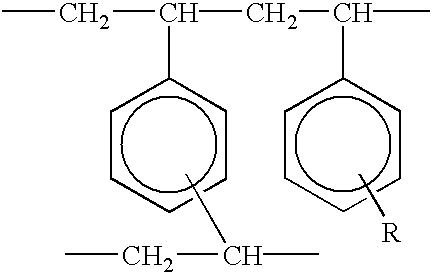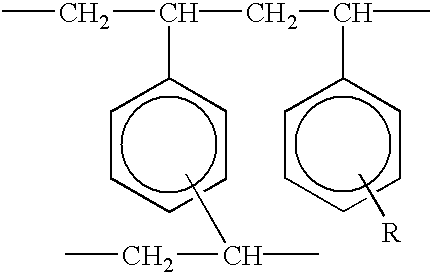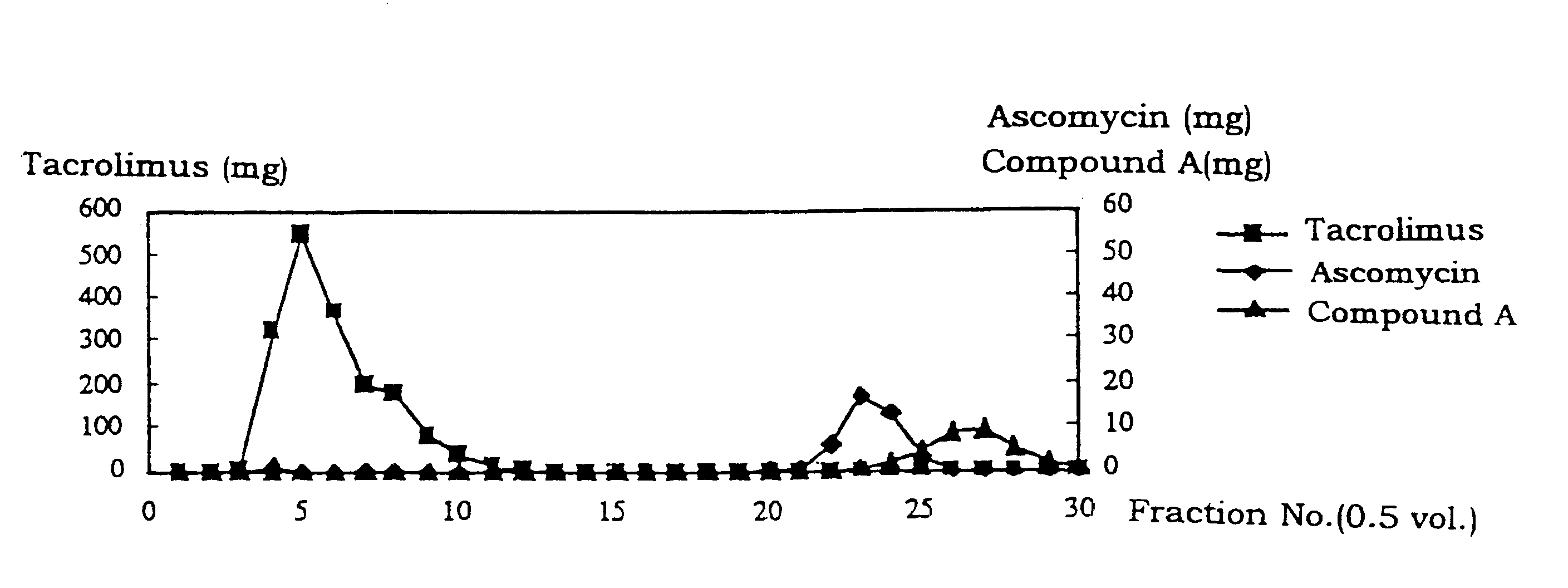Method for separating lactone-containing high-molecular weight compounds
a high-molecular weight, compound technology, applied in the direction of separation processes, organic chemistry, ion-exchangers, etc., can solve the problems of difficult to separate analogous compounds which are slightly and partially different in their molecular structure, and achieve the effect of effectively separating analogous compounds
- Summary
- Abstract
- Description
- Claims
- Application Information
AI Technical Summary
Problems solved by technology
Method used
Image
Examples
example 1
Separation by column chromatography using Diaion.RTM. HP20SS as a nonionic adsorption resin and an eluent containing silver nitrate
A mixture (200 mg) of tacrolimus, ascomycin and 17-propyl-1,14-dihyroxy-12-[2-(4-hydroxy-3-methoxycyclohexyl)-1-methylvinyl]-23,25-dimethoxy-13,19,21,27-tetramethyl-11,28-dioxa-4-azatricyclo[22.3. 1.0.sup.4.9 ]loctacos-18-ene-2,3,10,16-tetraone (referred to as "Compound A" hereinafter) in a 50% aqueous acetone was subjected to column chromatography using Diaion.RTM. HP20SS (20 mL) so that substances contained in the mixture were adsorbed. Next, tacrolimus, ascomycin and Compound A were eluted at room temperature by using a 50% (v / v) aqueous acetone containing silver nitrate (0.294 mol / L) and a 60% (v / v) aqueous acetone as eluents at a load of 9.5 g / L-R in terms of tacrolimus. A control test was also carried out in the same manner by using aqueous acetone as an eluent which does not contain silver nitrate. The results are shown in FIG. 1 and FIG. 2.
example 2
Separation by column chromatography using Diaion.RTM.& HP20SS as a nonionic adsorption resin and a silver nitrate eluent
The crude sample (300 mL) obtained in Preparation Example 1 was subjected to column chromatography using Diaion.RTM. HP20SS (20 mL) so that contained substances were adsorbed. The column was washed with 40% aqueous acetone (100 mL). Thereafter, a mixture of tacrolimus and 17-allyl-1,14-dihyroxy-12-[2-(3,4-dihydroxycyclohexyl)-1-methylvinyl]-23,25-dimethoxy-13,19,21,27-tetramethyl-11,28-dioxa-4-azatricyclo[22.3.1.0.sup.4.9 ]octacos-18-ene-2,3,10,16-tetraone (referred to as "Compound B" hereinafter) were eluted at room temperature by using as an eluent a 50% (v / v) aqueous acetone containing silver nitrate (0.294 mol / L). Subsequently, under the same conditions, a mixture of ascomycin and Compound A were eluted separately by using 60% (v / v) aqueous acetone.
The quantity of each compound contained in the separate fractions thus obtained was measured by HPLC analysis (mob...
example 3
Separation by column chromatography using, a basic active alumina, AC12
The fractions containing the mixture of tacrolimus and Compound B obtained in Example 2 were concentrated and extracted with ethyl acetate. An organic layer was dried with magnesium sulfate and then evaporated to dryness. The obtained residue was subjected to column chromatography using a basic active alumina, AC 12 (20 mL) packed with ethyl acetate. At room temperature, elution was carried out by using ethyl acetate (400 mL) as an eluent and separate fractions (20 mL.times.1 and 200 mL.times.2) were obtained.
The quantity of each compound contained in the separate fractions thus obtained was measured by HPLC analysis in the same manner as in Example 2. The results of separation of tacrolimus and compound B are shown in Table 2.
As clearly seen from Table 2, by absorbing the mixture of a lactone-containing high-molecular weight compound having a lower alkoxy group as its side-chain (tacrolimus) and their analogous ...
PUM
| Property | Measurement | Unit |
|---|---|---|
| flow rate SV | aaaaa | aaaaa |
| pH | aaaaa | aaaaa |
| pH | aaaaa | aaaaa |
Abstract
Description
Claims
Application Information
 Login to View More
Login to View More - R&D
- Intellectual Property
- Life Sciences
- Materials
- Tech Scout
- Unparalleled Data Quality
- Higher Quality Content
- 60% Fewer Hallucinations
Browse by: Latest US Patents, China's latest patents, Technical Efficacy Thesaurus, Application Domain, Technology Topic, Popular Technical Reports.
© 2025 PatSnap. All rights reserved.Legal|Privacy policy|Modern Slavery Act Transparency Statement|Sitemap|About US| Contact US: help@patsnap.com



